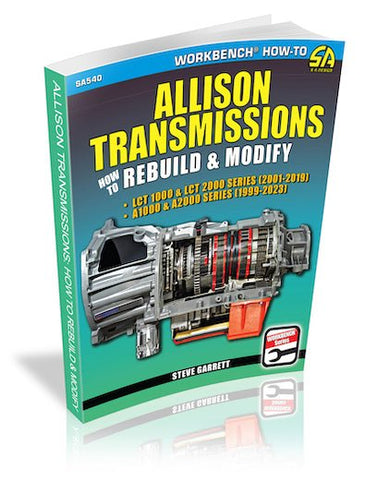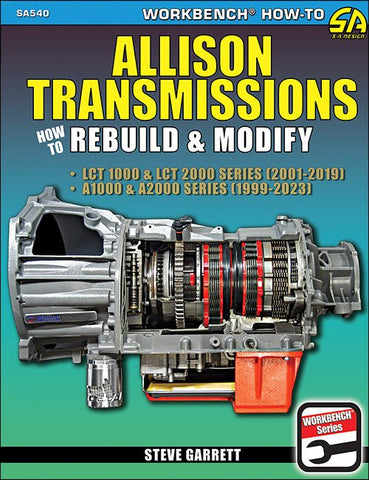Introduced in 1999 by Allison and 2001 by General Motors, the Allison 1000- and 2000-series transmissions have become the most popular heavy-duty transmissions in production today. Used by multiple manufacturers, including GM, Freightliner, International, etc., millions are on roads around the world.
Automatic transmissions are often seen as mysterious and overly complicated, but much of the guesswork has been simplified to its basic elements in this easy-to-follow guide. This book covers the identification process, operation, diagnostic pointers, common failures, and repair and rebuild procedures for the 1000- and 2000-series transmissions. Upgrades to make the 1000 more robust for performance applications are covered as well as the companies that offer upgrades.
This detailed instructional manual is authored by Steve Garrett, a service engineer and instructor for General Motors and a member of the Automatic Transmission Rebuilders Association (ATRA). Quality photos of the rebuild process are featured along with torque specifications and identification of all major and most minor components. If you are looking at performing a rebuild project on your own or you just want to know how your Allison works, this is the book for you.
Chapter 1: LCT 1000 and 2000 Allison Operation and Service
Generations
Transmission Identification
RPO Identification
LCT 1000 Unit Specifications
PTO and Non-PTO Applications
Fluids and Inspection
Filter and Fluid Service
Bolt and Fastener Torque Specifications
Tools
Power and Ground Testing
Electrical Current Flow
TCM Power-Side Testing the LCT 1000 and 2000
TCM Ground-Side Testing the LCT 1000 and 2000
Adhesives, Sealers, and Lubricants
Cooler Flushing
Transmission Inspection
Chapter 2: Mechanical Components
Range and Power Flow
LCT 1000 and 2000 Electronic Components
Solenoid State and Operation
TFT Sensor
PSA
Gen 1–3 Range Sensor (1999–2005)
Gen 4–5 IMS (2006 and Later)
Speed Sensors: ISS, OSS/VSS, and TSS
TCM Shared Data and Additional Inputs
Scan Tool Diagnosis, Data Parameters, DTCs, and Programing
Adaptive Learning, Clearing Adapts, and Relearning Adapts
On-Vehicle Repairs and Adjustments
Pressure Testing, Clutch Testing, and Road Testing Components
Cleaning Components
Component Inspection
Chapter 3: Component Service Disassembly and Assembly
Torque Converter Removal
Holding Fixture
Spin-On Filter, Speed Sensors, and Transmission Range Sensor Removal
Oil Pan and Filter Removal
End Play Measurement
Extension Housing and 4WD Adapter Removal
Valve Body Removal
Shift Shaft Removal
Bellhousing and Pump Service
The Stator Support
Pump Component Assembly
Clutch and Planetary Removal and Service
Turbine and Input Shaft Installation
C1 and C2 (1-2-3-4/4-5-6) Clutch Measurements
C1 (1-2-3-4) Clutch Installation
C2 (4-5-6) Clutch Installation
C3 (3-5-R) and C4/C5 Clutch Removal, and P1, P2, and P3 Planetary Service
Bushing Replacement
Case Inspection, Service, and Output Seal Replacement
Assembly of C3/C4/C5 Clutches and Planetaries
Mainshaft P2 and P3 Sun Gears
C5 Clutch Piston Installation
Extension Housing and 4x4 Adapter Housing Installation
C1 and C2 Clutch Drum Installation
Bellhousing and Pump Installation
Aftermarket End Play Measurement
Air Testing
Speed Sensor Installation
Spin-on Oil Filter Installation
PTO Cover Installation
Range Sensor Installation
Chapter 4: Electronic Control System
Bench Testing Components
Valve Body Service
Valve Body Installation
Oil Filter and Oil Pan Installation
Fluid Capacity, Initial Fill, Checks, and Operation
On-Vehicle Repairs and Adjustments and Range Selector Cable Adjustments
Adaptive Learning, Clearing Adapts, and Relearning Adapts
Allison 1000 in a Non-OEM Application
Performance Clutch Manufacturers
Diagnostic Pointers
Appendix: Allison Diagnostic Trouble Codes and Diagrams
Introduced in 1999 by Allison and 2001 by General Motors, the Allison 1000- and 2000-series transmissions have become the most popular heavy-duty transmissions in production today. Used by multiple manufacturers, including GM, Freightliner, International, etc., millions are on roads around the world.
Automatic transmissions are often seen as mysterious and overly complicated, but much of the guesswork has been simplified to its basic elements in this easy-to-follow guide. This book covers the identification process, operation, diagnostic pointers, common failures, and repair and rebuild procedures for the 1000- and 2000-series transmissions. Upgrades to make the 1000 more robust for performance applications are covered as well as the companies that offer upgrades.
This detailed instructional manual is authored by Steve Garrett, a service engineer and instructor for General Motors and a member of the Automatic Transmission Rebuilders Association (ATRA). Quality photos of the rebuild process are featured along with torque specifications and identification of all major and most minor components. If you are looking at performing a rebuild project on your own or you just want to know how your Allison works, this is the book for you.
Chapter 1: LCT 1000 and 2000 Allison Operation and Service
Generations
Transmission Identification
RPO Identification
LCT 1000 Unit Specifications
PTO and Non-PTO Applications
Fluids and Inspection
Filter and Fluid Service
Bolt and Fastener Torque Specifications
Tools
Power and Ground Testing
Electrical Current Flow
TCM Power-Side Testing the LCT 1000 and 2000
TCM Ground-Side Testing the LCT 1000 and 2000
Adhesives, Sealers, and Lubricants
Cooler Flushing
Transmission Inspection
Chapter 2: Mechanical Components
Range and Power Flow
LCT 1000 and 2000 Electronic Components
Solenoid State and Operation
TFT Sensor
PSA
Gen 1–3 Range Sensor (1999–2005)
Gen 4–5 IMS (2006 and Later)
Speed Sensors: ISS, OSS/VSS, and TSS
TCM Shared Data and Additional Inputs
Scan Tool Diagnosis, Data Parameters, DTCs, and Programing
Adaptive Learning, Clearing Adapts, and Relearning Adapts
On-Vehicle Repairs and Adjustments
Pressure Testing, Clutch Testing, and Road Testing Components
Cleaning Components
Component Inspection
Chapter 3: Component Service Disassembly and Assembly
Torque Converter Removal
Holding Fixture
Spin-On Filter, Speed Sensors, and Transmission Range Sensor Removal
Oil Pan and Filter Removal
End Play Measurement
Extension Housing and 4WD Adapter Removal
Valve Body Removal
Shift Shaft Removal
Bellhousing and Pump Service
The Stator Support
Pump Component Assembly
Clutch and Planetary Removal and Service
Turbine and Input Shaft Installation
C1 and C2 (1-2-3-4/4-5-6) Clutch Measurements
C1 (1-2-3-4) Clutch Installation
C2 (4-5-6) Clutch Installation
C3 (3-5-R) and C4/C5 Clutch Removal, and P1, P2, and P3 Planetary Service
Bushing Replacement
Case Inspection, Service, and Output Seal Replacement
Assembly of C3/C4/C5 Clutches and Planetaries
Mainshaft P2 and P3 Sun Gears
C5 Clutch Piston Installation
Extension Housing and 4x4 Adapter Housing Installation
C1 and C2 Clutch Drum Installation
Bellhousing and Pump Installation
Aftermarket End Play Measurement
Air Testing
Speed Sensor Installation
Spin-on Oil Filter Installation
PTO Cover Installation
Range Sensor Installation
Chapter 4: Electronic Control System
Bench Testing Components
Valve Body Service
Valve Body Installation
Oil Filter and Oil Pan Installation
Fluid Capacity, Initial Fill, Checks, and Operation
On-Vehicle Repairs and Adjustments and Range Selector Cable Adjustments
Adaptive Learning, Clearing Adapts, and Relearning Adapts
Allison 1000 in a Non-OEM Application
Performance Clutch Manufacturers
Diagnostic Pointers
Appendix: Allison Diagnostic Trouble Codes and Diagrams










